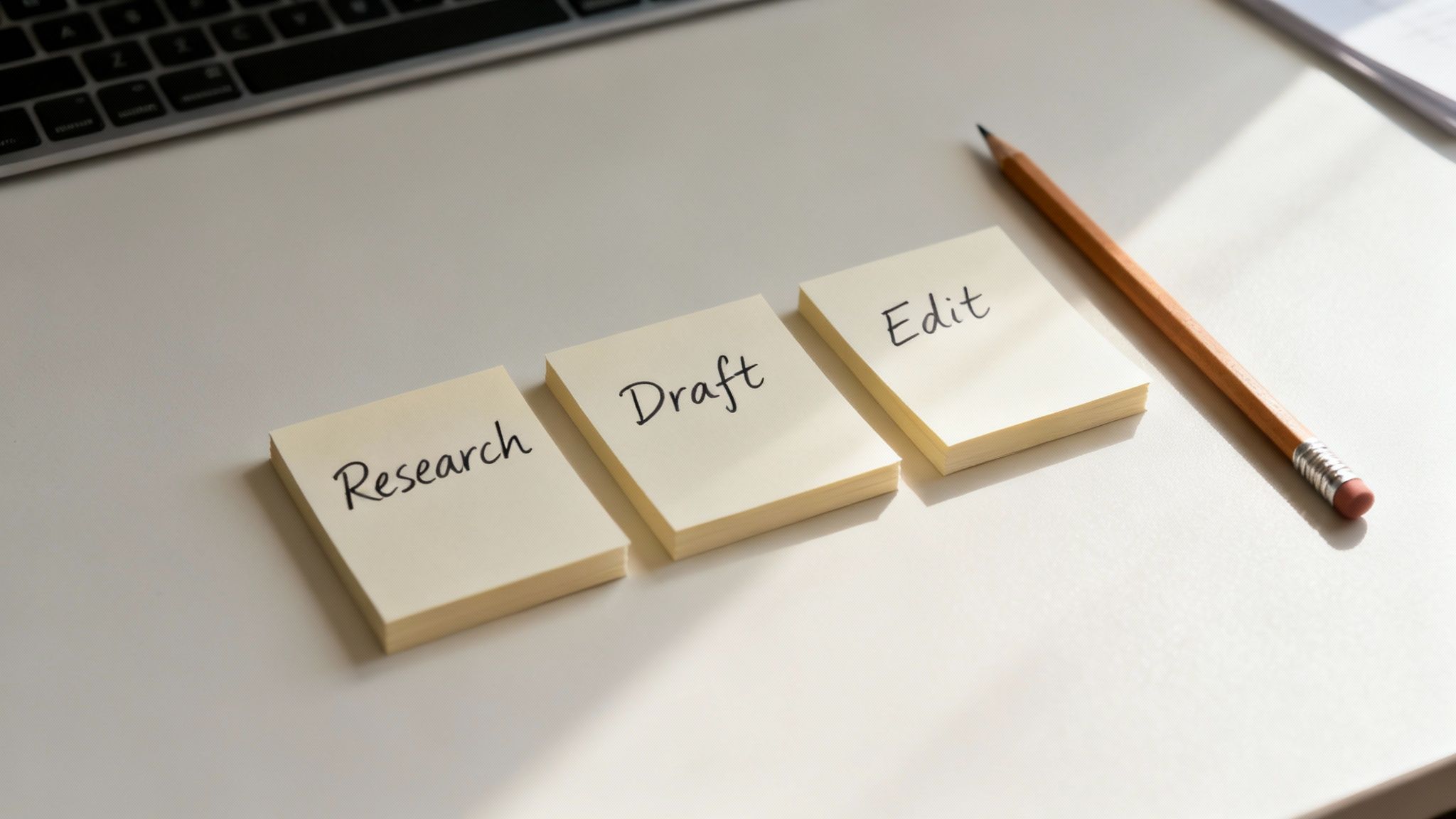You have the list. You know what you need to do. But starting feels like trying to push a car uphill. If you've ever stared at a task, feeling a mix of dread, overwhelm, and paralysis, you’re not alone. This isn't a failure of willpower or a sign of laziness; it's a common challenge with executive function, and many people with ADHD recognize this experience.
The mental friction between knowing and doing is called task initiation, and overcoming it is a skill. For many, the initial hurdle is the hardest part of any project, chore, or goal. This inertia can lead to procrastination, missed deadlines, and a persistent feeling of being stuck, which can be frustrating and impact self-esteem.
This article isn't about generic 'just do it' advice. We're exploring 10 science-grounded, practical task initiation strategies for adults that work with your brain, not against it. To effectively overcome this inertia, exploring broader resources on mastering behavioral intervention strategies can provide valuable frameworks. In this guide, you'll learn specific techniques to lower the barrier to entry, harness your motivation, and finally start moving forward on the things that matter to you.
1. The 2-Minute Rule
Popularized by James Clear in his book Atomic Habits, the 2-Minute Rule is a powerful task initiation strategy for adults who find starting to be the hardest part. The concept is simple: commit to working on any new task for just two minutes. By lowering the barrier to entry so significantly, you sidestep the mental resistance that often leads to procrastination and overwhelm.

The goal isn't to finish the task in two minutes, but to simply begin. This approach builds momentum, making it much easier to continue working once the initial two minutes are up.
🔬 It’s an effective tool against the task paralysis that is common among people with ADHD. To learn more about this common challenge, you can read about the link between ADHD and task paralysis in our blog.
How to Implement the 2-Minute Rule
💡 Set a visible timer: Use your phone or a physical timer and place it where you can see it. Watching the countdown creates a clear, finite commitment.
💡 Define a "two-minute version" of your task:
- Instead of: "Clean the entire kitchen."
- Try: "Wipe down one counter" or "Load five dishes into the dishwasher."
- Instead of: "Write the report."
- Try: "Open the document and write a single sentence."
💡 Celebrate the start: Once the timer goes off, acknowledge that you successfully started. This positive reinforcement trains your brain to see starting as a win, even if you decide to stop.
Have you noticed how the first small step is often the hardest?
2. The Pomodoro Technique
Developed by Francesco Cirillo in the late 1980s, the Pomodoro Technique is a time management method designed to break down work into focused, manageable intervals. It’s an ideal task initiation strategy for adults who feel daunted by large, undefined blocks of work.

🔬 The technique involves setting a timer for a 25-minute work session (called a "pomodoro"), followed by a short break. This creates a rhythm that makes starting feel less intimidating and leverages a sense of urgency, as the ticking clock encourages you to stay on task until the planned break.
For adults, especially those with ADHD, knowing a break is always just around the corner significantly lowers the mental barrier to getting started. It transforms an endless task into a series of small, achievable sprints. To help you apply this technique, you might find a dedicated Pomodoro Timer like DeskBreak useful.
How to Implement the Pomodoro Technique
💡 Choose a task and set your timer: Decide on one single task to focus on and set a timer for 25 minutes. Commit to working on only that task until the timer rings.
💡 Protect your breaks: When the timer goes off, take a 5-minute break. It's crucial to use this time to truly disconnect. Step away from your screen, stretch, or get a glass of water. After four pomodoros, take a longer break of 15-30 minutes.
💡 Adjust your intervals: The classic 25/5 minute split is a great starting point, but feel free to experiment. You might find a 15-minute sprint is best for tasks you're avoiding.
💡 Track and gamify: Keep a simple tally of how many pomodoros you complete each day. This creates a sense of accomplishment and can motivate you to start the next session.
3. Implementation Intentions (If-Then Planning)
Developed by psychology researcher Peter Gollwitzer, Implementation Intentions are a powerful cognitive strategy for turning goals into automatic actions. This method involves creating a specific plan in an "if-then" format: If situation X happens, then I will perform action Y.
🔬 By creating a strong link between a specific situation and a desired behavior, you reduce the mental energy required for task initiation. This approach is particularly effective for adults with executive function challenges, as it removes the in-the-moment decision making that can feel overwhelming.
This pre-commitment effectively outsources your decision to start a task to an external cue, bypassing the mental negotiation that often leads to procrastination. It essentially programs your brain to act on autopilot when a specific trigger occurs, making starting a task feel less like a choice and more like a reflex.
How to Implement If-Then Planning
💡 Link new tasks to existing habits: This technique, often called "habit stacking," uses the momentum from an established routine to launch a new one.
- Instead of: "I'll meditate sometime in the morning."
- Try: "If I finish my first cup of coffee, then I will immediately sit down for a five-minute meditation."
- Instead of: "I need to start studying for my exam."
- Try: "If I sit down at my desk after dinner, then I will open my textbook and read one page."
💡 Be specific and visible: Vague plans often fail. Clearly define both the "if" (the cue) and the "then" (the action). Write your if-then statements down on a sticky note and place it where you'll see it.
💡 Use environmental triggers: Your surroundings can be powerful cues. For example: "If I put my gym clothes on the end of my bed the night before, then I will put them on as soon as my alarm goes off."
4. Temptation Bundling
Coined by behavioral economist Katherine Milkman, temptation bundling is a brilliant strategy that links something you want to do with something you need to do. This powerful task initiation strategy for adults works by pairing a desirable activity (the "temptation") with a task you've been avoiding.
By doing so, you leverage the immediate reward of the enjoyable activity to make the less appealing task more attractive. This approach essentially "bribes" your brain into getting started.
🔬 The positive feelings associated with the reward become linked to the task itself, reducing the mental friction that causes procrastination. It’s a way to harness your existing desires to fuel your productivity, making it particularly effective for those who struggle with motivation for routine or mundane chores.
How to Implement Temptation Bundling
💡 Identify your unique temptations: Make a list of "guilty pleasures" or simple joys. This could be listening to a specific podcast, watching a reality show, or drinking a fancy coffee. The key is that the reward must be genuinely motivating for you.
💡 Create your bundles: Pair a specific temptation with a specific task.
- Instead of: "I have to fold the laundry."
- Try: "I get to watch my favorite Netflix show, but only while I'm folding the laundry."
- Instead of: "I need to respond to work emails."
- Try: "I'll go to my favorite coffee shop and get a latte to sip on while I clear my inbox."
💡 Be strict with the pairing: The magic of temptation bundling fades if you enjoy the reward without doing the task. Reserve your chosen "temptation" exclusively for its bundled task to maintain its motivational power. This creates a strong, conditioned response over time.
Could pairing something you love with a task you dread make it easier to begin?
5. Environmental Design & Friction Reduction
Popularized by authors like James Clear and BJ Fogg, environmental design is one of the most effective task initiation strategies for adults. The core idea is simple: consciously structure your physical and digital spaces to make starting good habits easy and starting bad habits hard.
By reducing the friction, or the number of steps and obstacles between you and a task, you make initiation nearly effortless.
🔬 This strategy works by removing the need for willpower or motivation, which can be inconsistent resources, especially for adults with ADHD. Instead of fighting against your environment, you make it your greatest ally in productivity. It transforms your surroundings from a source of distraction into a launchpad for action.
How to Implement Environmental Design & Friction Reduction
💡 Apply the '10-Second Rule': If it takes more than 10 seconds to find what you need to start a task, your environment has too much friction. Audit your common tasks and streamline them.
💡 Set up 'Task Initiation Stations':
- Instead of: "I'll go for a run later."
- Try: Laying out your running shoes, clothes, and headphones by the door the night before.
- Instead of: "I need to work on my budget."
- Try: Creating a "budget" folder on your desktop with all relevant spreadsheets and login links, ready to open in one click.
💡 Increase friction for distractions: If you get pulled into social media, move the app icons off your home screen into a folder. This tiny extra step can be enough to break the automatic habit and redirect your focus.
6. Task Breakdown & Micro-Commitments
This strategy combats overwhelm by deconstructing large, intimidating projects into a series of smaller, more concrete micro-tasks. Popularized by David Allen's Getting Things Done (GTD) methodology, this approach shifts your focus from an intimidating final goal like "start a business" to a manageable, actionable first step like "research three potential business names." This is one of the most effective task initiation strategies for adults facing a daunting project.

🔬 By creating a clear sequence of small wins, you generate momentum and reduce the mental friction that causes procrastination. Instead of being paralyzed by the sheer size of a task, you build confidence with each completed component.
This method is crucial for developing the skills needed to see projects through to completion. You can explore more strategies for this in our guide on how to finish what you start.
How to Implement Task Breakdown
💡 Use action-oriented language: Start each micro-task with a clear verb.
- Instead of: "Presentation slides."
- Try: "Write the outline for the presentation" or "Find five images for the slides."
- Instead of: "House cleaning."
- Try: "Clear the kitchen counter" or "Fold one load of laundry."
💡 Make subtasks session-sized: Each broken-down step should ideally be completable in a single, focused work session (e.g., 25-45 minutes). This provides a sense of accomplishment and a natural stopping point.
💡 Visualize the process: Use tools like Notion, Asana, or even a simple notebook to list your micro-tasks. Seeing the path from start to finish makes the overall project feel far less abstract and much more achievable.
7. Accountability Systems & External Commitment
Using external commitment is a powerful task initiation strategy for adults who find internal motivation unreliable. This method leverages social pressure, financial stakes, or structured check-ins to create external reasons to start a task. By making a commitment to another person or system, you activate principles of loss aversion and social reputation, making the cost of inaction higher than the discomfort of starting.
🔬 This approach is particularly effective because it outsources the "executive" function of getting started to an external source. Platforms like Beeminder have popularized using financial stakes, while coaching and mentorship programs build on structured, supportive accountability.
For many adults with ADHD, an accountability partner can provide the necessary structure to overcome executive dysfunction. To dive deeper into this, you can learn more about how ADHD accountability partners combat executive dysfunction on getinflow.io.
How to Implement Accountability Systems
💡 Find an accountability partner: This can be a friend, colleague, or mentor. Schedule brief, regular check-ins (e.g., a 5-minute call each morning) to state your goal for the day and report on the previous day’s progress.
💡 Use commitment contracts:
- For a personal project: "I will write 500 words on my novel by Friday at 5 PM. If I don't, I will donate $20 to an organization I dislike."
- For a household chore: "I will tell my partner I am going to declutter the garage for one hour on Saturday morning."
💡 Leverage technology: Use apps to set goals with financial consequences or join online communities and coworking groups that have scheduled check-ins. The key is to make your intention public and measurable.
8. Dopamine Regulation & Energy Management
This neurochemical approach, popularized by researchers like Stanford neuroscientist Andrew Huberman, treats task initiation as a biological process. It recognizes that starting tasks depends heavily on adequate dopamine levels for motivation and focus. Instead of fighting low motivation with willpower, this strategy involves actively managing your brain's chemistry to make starting feel easier and more natural.
🔬 The core idea is to reduce activities that drain dopamine (like endless social media scrolling) and increase activities that naturally boost it. By optimizing your neurochemical state, you create an internal environment where motivation can actually flourish.
This is one of the most fundamental task initiation strategies for adults because it addresses the root cause of procrastination, not just the symptoms. For a deeper dive, you can learn more about how to naturally manage dopamine levels with getinflow.io.
How to Implement Dopamine Regulation
💡 Prioritize foundational habits: Your brain's chemistry is built on a foundation of sleep, nutrition, and movement.
- ✅ Sleep: Aim for 7-9 hours of consistent sleep, as this is when your brain replenishes its dopamine stores.
- ✅ Exercise: Morning cardio or even a brisk walk can significantly increase dopamine levels for hours.
- ✅ Sunlight: Get 10-15 minutes of direct sunlight exposure shortly after waking to help regulate your circadian rhythm and dopamine system.
💡 Manage your dopamine "budget":
- Instead of: Scrolling through social media for an hour before starting a big project.
- Try: Saving highly stimulating activities (like gaming or watching your favorite show) as a reward for after you've completed a focused work session. This builds anticipation, which itself increases dopamine.
💡 Track your energy and motivation: Pay attention to how different activities make you feel. Notice which foods, social interactions, or digital habits leave you feeling drained versus energized. This self-awareness is key to making sustainable changes.
9. Visual Cues & Progress Tracking
Making progress tangible is a powerful psychological tool. This strategy leverages that by turning your tasks and habits into something you can see. Using visual cues and tracking systems makes your efforts concrete, creating a rewarding feedback loop that fuels motivation. This is one of the most effective task initiation strategies for adults because it gamifies effort and provides an immediate sense of accomplishment.
🔬 This approach transforms abstract goals into a visible journey. When you can literally see the chain of completed days growing or a progress bar filling up, you tap into your brain's natural desire for completion and reward.
This is especially helpful for adults with ADHD, as it provides the external structure and dopamine hits needed to sustain focus and overcome initiation hurdles.
How to Implement Visual Cues & Progress Tracking
💡 Choose a method that excites you: The best system is one you'll actually use. This could be a sleek app, a colorful wall calendar, or a simple notebook. The visual appeal and satisfying interaction are key.
💡 Track actions, not just outcomes:
- Instead of: Tracking "lose 5 pounds."
- Try: Marking off every day you complete a 20-minute walk.
- Instead of: A goal of "finish the project."
- Try: A chart showing tasks completed each day.
💡 Make it visible and simple: Place your tracker where you can't miss it, like on your desk or the refrigerator. The goal is to create a constant, gentle reminder of your commitment. A simple checkmark or 'X' is often enough to reinforce the behavior.
Have you ever found satisfaction in checking an item off a list? This is that feeling, supercharged.
10. Social Modeling & Identity-Based Initiation
This psychological strategy leverages two powerful forces: our tendency to imitate others and our desire to act consistently with our self-image. Popularized by experts like Albert Bandura (social learning) and James Clear (identity-based habits), this approach helps you sidestep internal resistance by shifting your focus from the task itself to the person you are becoming.
🔬 It's one of the most effective task initiation strategies for adults because it reframes action as an expression of identity. Instead of mustering willpower to do something you dread, you simply act in alignment with your chosen identity.
This is particularly potent for adults with ADHD, as it can help override executive function deficits by tapping into a deeper, more intrinsic form of motivation. You stop trying to force an action and start being the kind of person who takes that action naturally.
How to Implement Social Modeling & Identity
💡 Define your desired identity: Don't focus on the outcome; focus on the person you want to be.
- Instead of: "I need to write a novel."
- Try: "I am a writer. Writers write every day, even when it's hard."
- Instead of: "I have to work out."
- Try: "I am an active person who prioritizes movement."
💡 Engage in social modeling: Surround yourself, either physically or virtually, with people who embody the identity you want to adopt. Join a running club, a co-working space for freelancers, or an online community for artists. Observing their behaviors makes it easier to model them.
💡 Use identity-affirming language: Pay attention to your self-talk. Each time you complete a small action, reinforce the identity. After putting away one dish, tell yourself, "See? I'm the kind of person who keeps a tidy space." This builds evidence for your new self-concept.
Start Small, Start Now: Your Personalized Action Plan
You’ve just navigated a toolkit of ten powerful task initiation strategies for adults. We’ve explored everything from the simple brilliance of the 2-Minute Rule to the psychological depth of Identity-Based Initiation. Each strategy offers a unique key to unlock the door that stands between intention and action—a door that can feel especially heavy for those with ADHD.
The journey from knowing to doing is where the real transformation happens. The goal is not to feel overwhelmed by choice or pressured to implement all ten strategies by tomorrow. Instead, the most crucial takeaway is this: progress is born from experimentation, not perfection.
From Insight to Action
The power of these techniques lies in their ability to meet you where you are.
✅ Feeling Overwhelmed? Start with Task Breakdown & Micro-Commitments. What is the absolute smallest first step you can identify?
✅ Lacking Motivation? Try Temptation Bundling. Pair that dreaded chore with something you genuinely enjoy.
✅ Need External Structure? Lean into Accountability Systems. Send that text to a friend or use a focus app to create gentle pressure.
Your brain is unique, and what works today might be different from what works next month. The key is to approach this list not as a rigid rulebook, but as a flexible menu of options. Select one strategy that resonates with your current challenge. Just one. Commit to trying it on a single task. Observe what happens without judgment. This small, intentional act is a powerful form of self-compassion and the first step toward building sustainable momentum.
Building Your Momentum Engine
Mastering task initiation is more than just checking items off a to-do list; it's about reclaiming your sense of agency and building self-trust. Every time you successfully start a task you were avoiding, you send a powerful message to yourself: “I am capable of doing hard things.” This cycle builds confidence, reduces the anxiety tied to procrastination, and helps rewire the neural pathways that have kept you stuck.
💡 Your Next Step: Choose one strategy from this article. Identify one small, low-stakes task you’ve been putting off. Apply the strategy and see what happens. That’s it. You don’t need a perfect plan; you just need a starting point.
If you recognize these patterns and feel ready for a more guided approach to building these skills, Inflow is designed to help. Our app offers a structured, science-backed program that breaks down concepts like these into daily, bite-sized lessons and practical exercises tailored for the ADHD brain. We help you understand the why behind your challenges and build the how of sustainable change.






